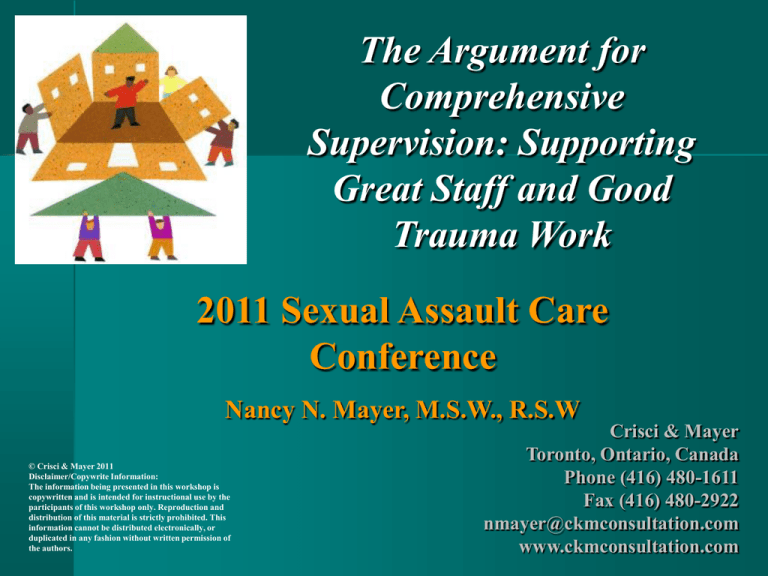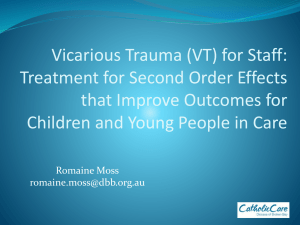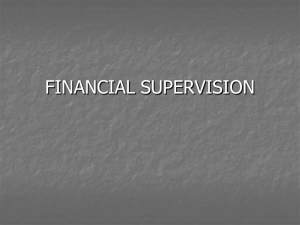NSAC11_The_Argument_for_Comprehensive_Supervision
advertisement

The Argument for Comprehensive Supervision: Supporting Great Staff and Good Trauma Work 2011 Sexual Assault Care Conference Nancy N. Mayer, M.S.W., R.S.W © Crisci & Mayer 2011 Disclaimer/Copywrite Information: The information being presented in this workshop is copywritten and is intended for instructional use by the participants of this workshop only. Reproduction and distribution of this material is strictly prohibited. This information cannot be distributed electronically, or duplicated in any fashion without written permission of the authors. Crisci & Mayer Toronto, Ontario, Canada Phone (416) 480-1611 Fax (416) 480-2922 nmayer@ckmconsultation.com www.ckmconsultation.com The Argument for Comprehensive Supervision Workshop Objectives: •Be able to identify the potential difficulties that workers experience when working with sexual assault victims •Understand how solid clinical supervision assists workers in providing good services •Understand a two-tiered supervision model that accommodates staff needs for clinical supervision as well as creating a safe space to explore personal reactions to clients •Recognize when to utilize external consultants to assist staff There are significant challenges in working with people who have been sexually assaulted Traumatic events result in clients being subjected to overwhelming, uncontrollable experiences that psychologically impact them and create feelings of helplessness, vulnerability, loss of safety, and loss of control Challenges Being able to establish safety can be difficult Developing a trusting therapeutic relationship is hard Through the telling of the traumatic experience, the therapist bears witness to the abuse Empathic engagement with the client makes knowing that story more difficult Potential Involvement with justice system - Potential Impact on therapeutic alliance - Potential risks/liability to therapist Transference and counter transference Intersecting lines between therapists personal history and life Impact of workplace politics Compassion Fatigue and Secondary Trauma Compassion Fatigue Compassion fatigue is a state experienced by those helping people in distress; it is an extreme state of tension and preoccupation with the suffering of those being helped to the degree that it is traumatizing for the helper. Dr. Charles Figley Vicarious Traumatization © Crisci & Mayer Vicarious Traumatization refers to the transformation in the trauma worker’s inner experience resulting from empathic engagement with clients’ trauma material. Pearlman and Saakvitne, 1995 © Crisci & Mayer Vicarious Traumatization Through exposure to clients’ graphic accounts of sexual abuse experiences and to the realities of people’s intentional cruelty to one another, and through the inevitable participation in traumatic reenactments in the therapy relationship, the therapist is vulnerable through her empathic openness to the emotional and spiritual effects of vicarious traumatization. Pearlman and Saakvitne, 1995 © Crisci & Mayer Vicarious Traumatization These effects are cumulative and permanent, and will be evident in both the workers professional and personal life. © Crisci & Mayer Vicarious Traumatization It is not the responsibility of our clients, nor in any way an indictment of them. It is an occupational hazard that must be acknowledged and addressed. Pearlman and Saakvitne, 1995 © Crisci & Mayer Secondary Trauma is a process, not an event © Crisci & Mayer IMPACT OF SECONDARY TRAUMA Causes Disruptions to one’s sense of: Meaning Connection Identity World View Tolerance Psychological needs Beliefs about self and others Interpersonal relationships Sensory memory Spirituality © Crisci & Mayer CONTRIBUTING FACTORS TO VICARIOUS TRAUMATIZATION Specific Characteristics of the Therapy/Relationship and its Context Particular Characteristics and Vulnerabilities of the Listener © Crisci & Mayer CONTRIBUTING FACTORS TO SECONDARY TRAUMA SITUATION Nature of the work Nature of the clientele Cumulative exposure Organizational context Social and cultural context Pearlman & Saakvitne, 1998 © Crisci & Mayer CONTRIBUTING FACTORS TO SECONDARY TRAUMA THERAPIST/LISTENER Personal History Personality and defensive styles Current life context Training and professional history Personal Therapy Pearlman & Saakvitne, 1998 © Crisci & Mayer Very few epidemiological studies in the workplace – some with firefighters, police, soldiers Studies challenge previous belief that PTSD was a normal response to a traumatic event and can occur to anyone © Crisci & Mayer Research suggests that those who “get” PTSD are influenced by: • a specific predisposition to PTSD • a predisposition to mental illness that can be triggered by adversity • the actual traumatic event and the meaning of that event © Crisci & Mayer Why a Two Tiered Model of Supervision Supports Great Staff and Good Trauma Work Supervision Is the cornerstone to sound clinical practice. It provides oversight and accountability Having others examine the work we do with clients gives us the opportunity to become knowledgeable about issues outside our awareness Getting feedback and another point of view can improve effectiveness It’s a Professional Thing to Do All mental health workers will be affected by the work they do It is professional behaviour to acknowledge these feelings and examine them to ensure no harm comes to clients Not to do so can result in unprofessional behaviour and potential professional misconduct and error Kadushin’s Definition of Supervision A supervisor is an agency administrative staff member to whom authority is delegated to direct, coordinate, enhance, and evaluate on-the-job performance of the supervisees for whose work she/he is held accountable. In implementing this responsibility the supervisor performs administrative, educational, and supportive functions in interaction with the supervisee in the context of a positive relationship. The supervisor’s ultimate objective is to deliver to agency clients the best possible service, both quantitative and qualitative, in accordance with agency policies and procedures. © Crisci & Mayer, 2003 It is management’s job to manage and ensure implementation of the goals, missions, policies and procedures of an organization. Staff are accountable to their managers, the managers to the executive director and the executive director to the Board. The board is accountable to the funders and the wider community Community Board E.D. CL W Human Service Organizations Focus of this Model Administrative - the promotion and maintenance of good standards of work, co-ordination of practice with policies of administration, the lines of accountability are clear Educational - the educational development of each individual worker on the staff in keeping with the organizations mission, policies and procedures Supportive - the maintenance of a positive working relationship focused on providing the best possible service to the client’s Limitations of Internal Supervision Client’s needs are paramount – which may limit Organizational accountability issues and the supervisors role in performance appraisal and discipline issues can negatively effect – trust with personal information Need to maintain boundaries – supervisors should not become “therapists” to their staff Potential issues when supervisee’s therapists do supervision Case for Ongoing Supervision Allows ongoing evaluation and feedback Mechanism for contact and accountability Tool to contain anxiety and problem-solve Educational opportunity Promotes fair work evaluation Supports good casework Vehicle for Support Case for Two Tiered Model of Supervision Internal supervision allows for ongoing evaluation of staff and accountability to the organization and its mission Since organization assumes liability, it should be responsible for setting case direction and making major case decisions The addition of a second form of supervision conducted by an external supervisor with groups of staff allows the staff to deal with the intersecting issues between casework and their personal life in private and without potential repercussions by organization (when the issues are not potentially libelous) Case for Group Supervision External Supervisor Group supervision allows staff to normalize that personal issues can effect the professional work if not monitored Allows staff to learn from each other Is cost effective. Conducting these sessions in groups makes the cost possible for most organizations Will promote staff cohesion Issues with Use of External Consultants for Organizations External consultant has a responsibility to the client and the organization to report issues that come up that could lead to liability for the organization and/or harm to the client There should be a written contract between the external supervisor with the organization and the staff that states the above The staff when ever possible will be encouraged to “report” themselves to their organization with the consultants support if necessary Examples: sexual exploitation of clients, staff impairment that would harm client In Summary Our experience has shown that the commonly used model of supervision with an internal supervisor has limitations, especially for trauma work The addition of group supervision with an external supervisor with clinical knowledge of trauma better addresses the issues raised in the literature about secondary trauma and compassion fatigue Together, both approaches provide the necessary resources to ensure good clinical work and support of good staff Crisci & Mayer In 1997, we started Crisci & Mayer, Consultation Counselling and Training, to provide services to professionals in the human services field. With our combined expertise and knowledge this partnership has been successfully offering counselling services to people seeking help for themselves or their family members and offering training to the professional community. We also provide consultation to professionals, both on an individual and an organizational basis. We are committed to improving the lives of people who have experienced trauma or who are struggling with individual, couple or family problems and to bringing innovative perspectives to our training and practice, based on the latest research and knowledge. 55 Eglinton Avenue East, Suite 506 Toronto Ontario Canada M4P 1G8 www.ckmconsultation.com (416) 480-1611 Geraldine Crisci, M.S.W. Nancy N Mayer, M.S.W., R.S.W. © Crisci & Mayer 2006 Disclaimer/Copyright Information: The information being presented in this workshop is copy written and is intended for instructional use by the participants of this workshop only. Reproduction and distribution of this material is strictly prohibited. This information cannot be distributed electronically, or duplicated in any fashion without written permission of the authors. Visit our website to learn more about upcoming training events and certification programs that may be beneficial for you www.ckmconsultation.com








